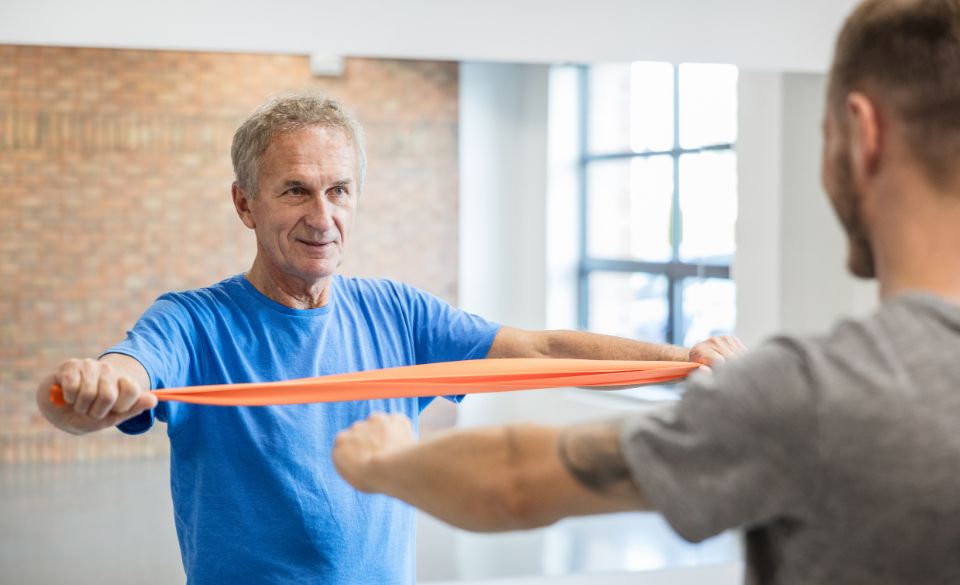
The Best Type of Exercise for Osteoporosis: A Complete Guide
Page Contents
As we age, maintaining strong and healthy bones becomes increasingly important. Osteoporosis, a condition characterized by low bone mass and deterioration of bone tissue, can significantly increase the risk of fractures and impact our overall quality of life. While there is no cure for osteoporosis, exercise has been shown to be a crucial component of managing and preventing this condition. In this article, we’ll explore the best types of exercise for osteoporosis and how they can help strengthen your bones for a healthier future.
The Science Behind Exercise and Osteoporosis
To truly understand the benefits of exercise for osteoporosis, it’s important to explore the science behind how physical activity can help strengthen your bones and combat this condition.
Osteoporosis is a condition characterized by low bone density and increased bone fragility. As we age, our bones naturally become less dense and more prone to fractures. However, certain lifestyle factors, including a sedentary lifestyle, can accelerate this process. That’s where exercise comes in.
When we engage in weight-bearing exercises, such as walking, running, or dancing, our bodies experience a mechanical load. This load stimulates the bones to adapt and become stronger. The force exerted on the bones during weight-bearing exercises signals the body to increase bone mineral density and promote bone remodeling.
Weight-bearing exercises are particularly effective for improving bone health because they involve working against gravity while standing. This type of activity places stress on the bones, which triggers the body’s natural bone-building response. Over time, this can lead to increased bone density, making the bones stronger and more resistant to fractures.
Resistance training, or strength training, is another important component of exercise for osteoporosis. This type of exercise involves using resistance, such as weights or resistance bands, to strengthen muscles and bones. By challenging the muscles and bones, resistance training stimulates bone remodeling and increases bone strength.
When we engage in resistance exercises, the muscles pull on the bones, creating tension and stress. This stress activates the bone cells responsible for building new bone tissue, called osteoblasts. As a result, bone density can improve, reducing the risk of fractures and promoting overall bone health.
In addition to weight-bearing exercises and resistance training, balance and posture exercises are also beneficial for individuals with osteoporosis. These exercises help improve stability, coordination, and posture, reducing the risk of falls and fractures. Examples of balance and posture exercises include standing on one leg, yoga, and tai chi.
Weight-Bearing Exercises: Building Strong Bones
Weight-bearing exercises are a key component of building strong bones and combating osteoporosis. These types of exercises involve working against gravity while standing, which puts stress on the bones and stimulates bone growth and remodeling.
Walking is one of the simplest and most accessible weight-bearing exercises. It’s a weight-bearing activity that you can easily incorporate into your daily routine. Whether it’s a brisk walk in the park or a stroll around your neighborhood, regular walking can have a significant impact on your bone health.
Jogging and running are more intense forms of weight-bearing exercises that can provide even greater benefits for bone strength. These activities involve higher impact forces, which further stimulate bone mineral density. However, it’s important to start slowly and gradually increase your intensity and duration to prevent overexertion and injury.
Dancing is another enjoyable weight-bearing exercise that can benefit your bones. Whether it’s salsa, ballet, or hip-hop, dancing involves dynamic movements that put stress on your bones, helping to improve bone density. Plus, dancing is a fun and social activity that can make exercise feel like a celebration.
Hiking is a great way to combine weight-bearing exercise with the beauty of nature. Trekking uphill and downhill on various terrains engages different muscles and adds variety to your workout routine. It’s a great way to challenge your bones while enjoying the great outdoors.
Incorporating weight-bearing exercises into your routine for at least 30 minutes most days of the week can have a significant impact on your bone health. Remember to start gradually, listen to your body, and choose activities that you enjoy. Consistency is key when it comes to reaping the benefits of weight-bearing exercises for building strong bones.
However, it’s important to note that not all weight-bearing exercises are suitable for everyone. If you have existing health conditions or concerns, it’s best to consult with your healthcare provider or a qualified exercise professional to ensure you choose exercises that are safe and appropriate for your individual needs.
Resistance Training: Strengthening Your Skeleton
Resistance training, also known as strength training, is a powerful tool for strengthening your skeleton and combating osteoporosis. Unlike weight-bearing exercises that primarily target the muscles, resistance training focuses on working the muscles against an external resistance, such as weights, resistance bands, or your body weight. This type of exercise promotes not only muscle growth but also bone health.
One of the primary benefits of resistance training for osteoporosis is that it puts stress on the bones, which stimulates the production of new bone tissue. As you perform resistance exercises, the muscles pull on the bones, creating tension and activating the cells responsible for bone remodeling and growth. Over time, this leads to increased bone density and improved bone strength, reducing the risk of fractures.
Weightlifting is a popular form of resistance training that can have significant benefits for your bones. By lifting weights, you challenge your muscles and bones, promoting bone mineralization and strengthening the skeletal system. It’s important to start with lighter weights and gradually increase the resistance as your muscles and bones adapt and grow stronger.
Resistance bands are another excellent tool for resistance training, especially for individuals with osteoporosis. These bands provide resistance throughout the full range of motion, allowing you to target specific muscle groups and stimulate bone remodeling. They are portable, affordable, and versatile, making them a convenient option for home workouts or when traveling.
Bodyweight exercises, such as push-ups, squats, and lunges, also fall under the category of resistance training. These exercises use your own body weight as resistance to build strength and bone density. They can be easily modified to suit your fitness level and provide a challenging workout for your muscles and bones.
It’s important to note that when engaging in resistance training, proper form and technique are crucial to prevent injuries. If you’re new to resistance training or unsure about the correct form, consider working with a qualified fitness professional who can guide you through the exercises and ensure you’re using proper technique.
To reap the benefits of resistance training for osteoporosis, aim to include strength training exercises at least two to three times a week. Focus on targeting major muscle groups, such as the legs, hips, back, chest, arms, and shoulders, to ensure overall muscle and bone strength.
Balance and Posture Exercises: Preventing Falls and Fractures
Balance and posture exercises are essential for individuals with osteoporosis as they help improve stability, coordination, and overall body alignment. By focusing on these exercises, you can significantly reduce the risk of falls and fractures, which is crucial for maintaining bone health and overall well-being.
One of the most effective balance exercises for osteoporosis is standing on one leg. Simply lift one leg off the ground and hold the position for as long as you can. This exercise strengthens the muscles in your legs and core while enhancing your balance and stability. Start by holding the position for a few seconds and gradually work your way up to longer durations as you build strength and confidence.
Yoga is another excellent practice that combines balance, posture, and flexibility. Many yoga poses challenge your stability while promoting proper alignment and posture. Poses like tree pose, warrior pose, and the mountain pose are particularly beneficial for improving balance and strengthening the lower body. Attending yoga classes or following online tutorials specifically designed for individuals with osteoporosis can provide guidance and ensure you perform the poses correctly and safely.
Tai chi is a gentle and low-impact exercise that focuses on slow, flowing movements and deep breathing. It emphasizes body awareness, balance, and coordination. Tai chi has been shown to improve balance, reduce the risk of falls, and enhance overall physical well-being. Taking classes or joining a tai chi group can be a great way to learn the movements and experience the benefits of this ancient practice.
In addition to specific exercises, it’s important to incorporate everyday activities that challenge your balance and posture. For instance, try standing on tiptoes while brushing your teeth or practicing balancing on one leg while waiting in line. These small adjustments to your daily routine can make a big difference in improving your overall stability and reducing the risk of falls.
Final Words
In summary, when it comes to osteoporosis, incorporating a well-rounded exercise routine that includes weight-bearing exercises, resistance training, and balance and posture exercises is essential for maintaining strong and healthy bones. Weight-bearing exercises such as walking, jogging, dancing, and hiking stimulate bone growth and increase bone mineral density. Resistance training, including weightlifting, using resistance bands, or performing bodyweight exercises, helps to strengthen muscles and bones, promoting bone remodeling and increasing bone strength. Balance and posture exercises, such as standing on one leg, yoga, and tai chi, improve stability, coordination, and body alignment, reducing the risk of falls and fractures.
The science behind exercise and osteoporosis reveals that weight-bearing exercises place stress on the bones, stimulating the production of new bone tissue and increasing bone density. Resistance training creates tension on the bones through muscle contraction, promoting bone remodeling and strengthening the skeletal system. Balance and posture exercises improve stability, coordination, and body alignment, reducing the risk of falls, which can be particularly dangerous for individuals with osteoporosis.
By incorporating a combination of these exercises into your routine and consulting with healthcare professionals or exercise specialists as needed, you can take proactive steps to manage and prevent osteoporosis. Building strong bones through exercise is a lifelong commitment, but the rewards are significant. With dedication, consistency, and a focus on bone health, you can improve your overall quality of life and enjoy a future with strong and resilient bones.




